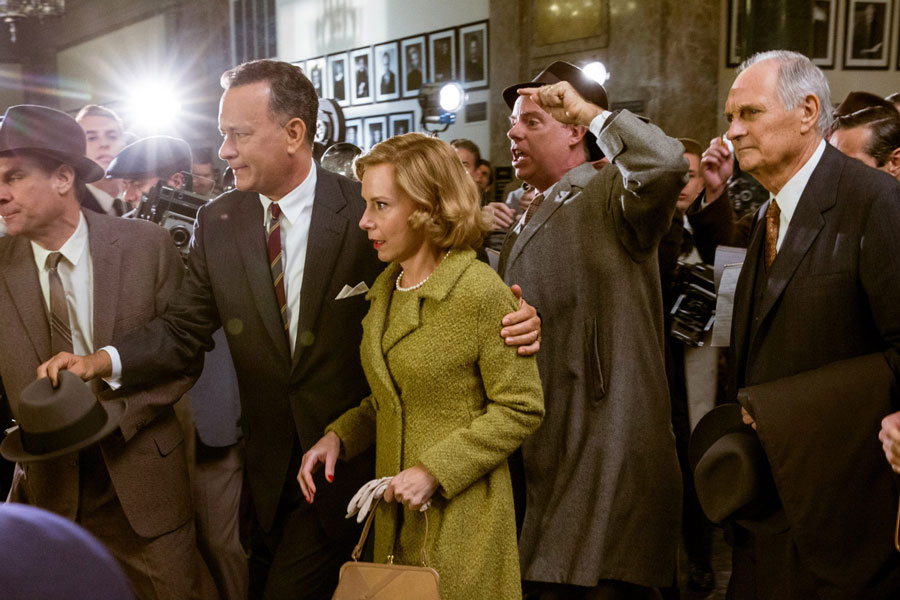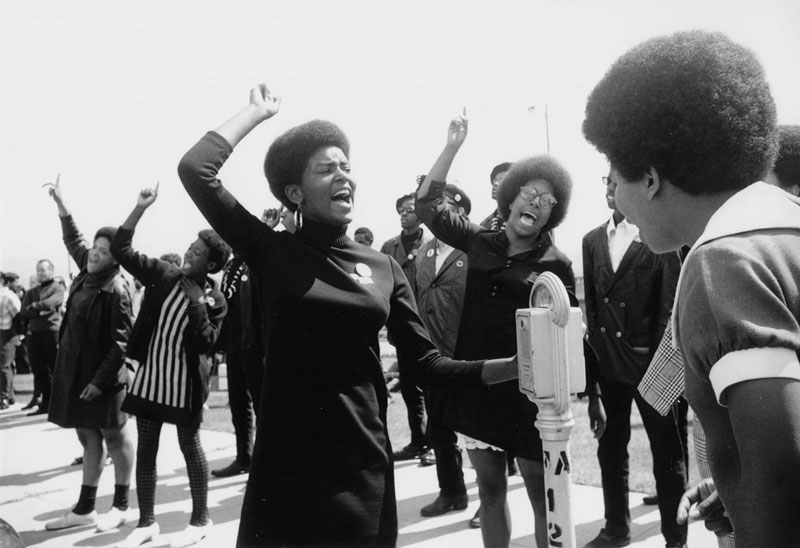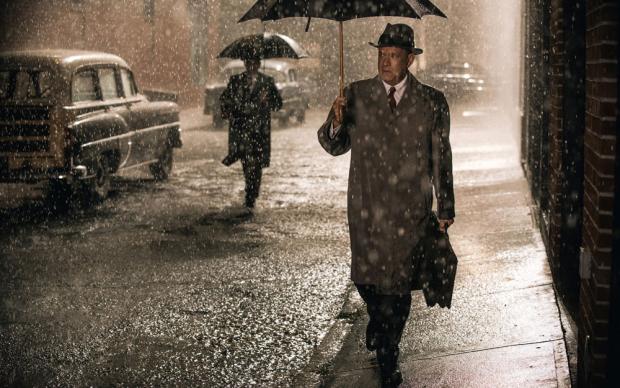Bridge of Spies, The Black Panthers: Vanguard of the Revolution
Every now and then, during the first half of Steven Spielberg’s Bridge of Spies, the movie indulges in little testimonials to America’s alleged unique heritage of civil liberties. They’re a little like mini-civics lessons, but at least they’re being delivered by the movie’s star, Tom Hanks. And what other Hollywood star would we want to lecture us about rights and liberties?
Both Hanks and the movie nicely recover from these. Eventually, the real-life character Hank portrays, lawyer James Donovan, gets to engage in some super-slick international horse trading, figuratively speaking, with that evil empire, The Union of Soviet Socialist Republics. Things begin in 1956, “the height of the Cold War,” and Donovan is a partner in a white shoe New York law firm, representing insurance companies, not the noblest of pursuits, but just wait. The man, at least in Bridge’s rendering, will show his mettle and humanity.

The first sequence in the movie has a man, Rudolf Abel (Mark Rylance), going to the East River, ostensibly to paint, in fact to retrieve secret microfilm from a park bench. He’s been frantically tailed by a squad of plainclothes types who arrest him in his hotel room. The opening sequence is tightly and dramatically shot and edited, and plays out tautly, commanding our close attention. But it’s also a little misleading because the rest of the picture doesn’t rely on such tense dynamics. This is largely a dialogue-driven film, and it’s surprisingly effective.
The story is “inspired by true events,” and how much they’ve altered them is a question you may be able to answer better than I. Here, Donovan is recruited to represent Abel, a Russian spy with a British passport and an English accent (neither of which is ever really explained). Abel is charged with a potentially capital crime (about which the movie is similarly vague) and Donovan is pressured by his senior partner (Alan Alda in a small, thankless role) who speaks of the cosmetic considerations: “We can’t look like our justice system tosses people on the ash heap.”
Donovan perseveres despite the odds, including popular patriotic anger, a biased judge, and his firm’s expectation that he won’t try too hard. He disappoints them, arguing Abel’s case up to the Supreme Court. Along the way, he forms a personal bond with his wry, stoically courageous client. Rylance, a distinguished British stage actor, provides a demonstration of the understated use of small, crucial performance elements. It’s quietly compelling work.
Bridge works something like two conjoined stories. The second one centers on Donovan’s increasingly fraught efforts in East Berlin to negotiate a trade of the Russian spy for captured American spy-plane pilot Francis Gary Powers. Spielberg, Hanks, and writers Matt Charman and the Coen brothers, Ethan and Joel, wring more intense interest from these scenes than you may think possible.
Except for a visually hyperbolic enactment of the shooting down of Powers’s plane over Russia, Bridge is a big, large-spirited movie that relies on small scenes of human interaction, sometimes only gestures. Hanks is a little too old for his role, but, particularly in the last half, he makes Donovan a dogged, deceptively forthright operator, and a very decent sort, as the lawyer tries to find his way through the combined maze and minefield of Cold War diplomacy.
Spielberg isn’t the most intellectually or aesthetically penetrating director of the last three decades—not nearly—but given good, exploitable material, he can expertly tell a story. With this one, he’s delivered again.
*
In 1966, when members of the Oakland, California Black Panther chapter walked onto the floor of the State Assembly in Sacramento carrying loaded long guns—then legal under California law—in order to protest proposed legislation aimed at them, they provoked more than the predictable outrage. Republicans, led by Ronald Reagan, called for gun-control measures. Stanley Nelson’s documentary, The Black Panthers: Vanguard of the Revolution, retells that episode with savage irony. (Actually, Panthers found themselves on the Assembly floor by mistake. They were looking for the gallery.)
Nelson adroitly relates the Panther party’s story (aided by editor Aljernon Tunsil) through newsfilm, images both commercial and amateur, and the recollections of people connected to that history. The movie concentrates on the years 1966-1975, and there’s a lot to relate. Nelson selects, emphasizes, and condenses events with discernment and technical skill. His movie provides an object lesson in accomplished documentary movie making. His achievement isn’t just one of technique. It’s also a result of sympathy and understanding.
One of the picture’s lessons is how large the Panthers loomed in Americans’ imaginations and fears in the several years of their prominence. It was both a kind of tribute and typically demagogic fear-mongering when FBI head J. Edgar Hoover called the Panthers the country’s “chief threat to national security,” a claim included in a brief film clip. He also said that “justice is only incidental to law and order,” which proved to be much closer to the truth in Hoover and Richard M. Nixon’s America.
The Panthers began in Lowndes County, Alabama in the mid-1960s, but they soon became a symbol of black urban militance in big cities. Their afros, black leather, and berets are as historically iconic as it gets. Their look and defiant rhetoric were as disruptive as anything in American political and social life 45 years ago except the anti-war movement. Black power wasn’t original to the party, but their sometimes theatrical and confrontational posture against racist power was the cause of unprecedented concern among whites and inspirational uplift for many young African Americans.
As Nelson makes clear, there was a brief period when the Panthers were the object of a degree of admiring popular media attention and the “radical chic” support Tom Wolfe famously mocked. It’s a little startling and amusing to see crooner and daytime TV talk show host Mike Douglas doing a segment about a Panther breakfast program for schoolchildren with Eldridge Cleaver.
Another of their story’s ironies is that the party was moving into more conventional social programs as Hoover’s FBI and local law enforcement came down on them. Former Weatherman and criminal fugitive, now Distinguished Professor of Education at the University of Illinois, Bill Ayres noted in his memoir, Fugitive Days, that as harassed and physically attacked by the Chicago cops as he and his white friends were, their situation was incomparably better than the Panthers’: Their Chicago leader Fred Hampton was murdered in his bed by Cook County police; all told, 27 Panthers were killed by various law enforcement agencies.
Nelson tells of the multi-pronged war against the party, but he goes further. He depicts the Panthers as products of the limiting, warping effects of their times and of American history. Their leadership was too often reckless and egoistic. (Former Young Lord Felipe Luciano calls Cleaver “fucking crazy.”)
The Panthers were no revolutionary vanguard, of course, but Nelson’s unsensational, tempered guidance provides a sense of unrealized possibilities. The film will be screened Wednesday, October 21 at 7pm at Burning Books, 420 Connecticut Street.

